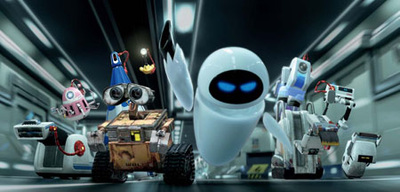Have you ever considered the deeper meaning behind a seemingly simple animated film? Pixar’s WALL-E, a tale of a lonely robot scavenging through a wasteland of discarded consumer goods, transcends its animated facade to present a stark and thought-provoking social commentary. More than just a children’s film, WALL-E serves as a powerful sociological story, exploring the consequences of our relationship with consumption, environmental destruction, and ultimately, our own humanity.

Image: nkvdexistentialanalysis.weebly.com
The film’s premise revolves around WALL-E, a solitary robot tasked with cleaning up Earth, now a uninhabitable wasteland. This setting, a direct consequence of unchecked consumerism and environmental neglect, serves as a grim backdrop for the film’s social message. Through WALL-E’s journey, Pixar masterfully weaves a compelling narrative that probes the very essence of human society, prompting us to question our collective future.
A Wasteland of Consumption
The Legacy of Consumerism
WALL-E paints a picture of a future ravaged by the insatiable hunger of consumerism. The Earth, now a vast landfill, is a testament to our obsession with accumulating and discarding goods. The film’s depiction of giant, abandoned shopping malls, mountains of discarded packaging, and rusted, forgotten items sends a stark message about the consequences of our throw-away culture. The film forces us to confront the weight of our consumption habits and the devastating impact they have on the environment.
The Human Cost of Excess
Beyond the environmental impact, WALL-E also underscores the human cost of excess consumerism. By portraying humans as obese and dependent on technology, the film subtly critiques the sedentary lifestyle and reliance on convenience that often accompany a consumerist society. The characters’ reliance on robotic assistance and pre-packaged meals highlights the potential for a loss of physical autonomy and the danger of becoming detached from our natural environment. These themes resonate with contemporary concerns about the social and human consequences of unchecked consumerism and the growing dependence on automation.

Image: www.theinsight.org
A Glimpse into Our Environmental Future
The Depiction of a Devastated Earth
The desolate landscape of WALL-E’s Earth serves as a cautionary tale about the consequences of environmental degradation. The film portrays a world choked with pollution, where nature has been replaced by an endless expanse of garbage. The arid, dusty wasteland, littered with the remnants of human civilization, serves as a stark reminder of the fragility of our planet and the dire consequences of unchecked pollution.
The Importance of Environmental Stewardship
WALL-E doesn’t simply offer a dystopian vision of the future; it also subtly emphasizes the importance of environmental stewardship. WALL-E’s simple act of collecting and preserving artifacts, including a single plant, portrays the value of finding beauty and hope amidst destruction. The film implicitly encourages us to take responsibility for safeguarding our environment, emphasizing the need for responsible consumption and sustainable practices to prevent a similar fate.
Humanity’s Connection with Nature
The Importance of Human Connection
Despite the bleak setting, WALL-E reminds us of the enduring human spirit. WALL-E’s solitary existence, his longing for connection, and his eventual encounter with Eve (the sleek, efficient probe sent to assess Earth) highlight the fundamental human desire for companionship and interaction. The film subtly underscores the importance of human connection and the need for social interaction in a world increasingly dominated by technology.
The Rediscovery of Human Potential
Through WALL-E’s journey, WALL-E suggests that the future of humanity may not be entirely bleak. The film portrays humans who, despite their dependence on technology, have not lost their capacity for compassion, curiosity, and ingenuity. The reawakening of their senses, triggered by WALL-E’s simple act of kindness, symbolizes the potential for humanity to re-engage with the world, reclaim its connection to nature, and forge a new path towards a more sustainable future.
Wall-E As Sociological Storytelling
A Call to Action
WALL-E‘s sociological storytelling transcends entertainment. It prompts us to examine our relationship with consumption and our responsibility towards the environment. The film serves as a powerful reminder that our actions today have consequences for the future. By understanding the social and environmental implications of our choices, we can strive to create a more sustainable world for ourselves and future generations. WALL-E not only entertains but also challenges, reminding us of our interconnectedness as humans and our responsibility as stewards of the planet.
The next time you watch WALL-E, consider it not just a children’s film, but a sociological story woven into entertaining animation. Through the lens of a lonely robot and a desperate planet, Pixar offers a powerful reflection of our own society, challenging us to consider our future before it becomes the reality depicted in this poignant animated masterpiece. Let WALL-E‘s message serve as a catalyst for positive change, prompting us to embrace sustainable practices and ensure a future where our planet remains not just a wasteland, but a haven for generations to come.





